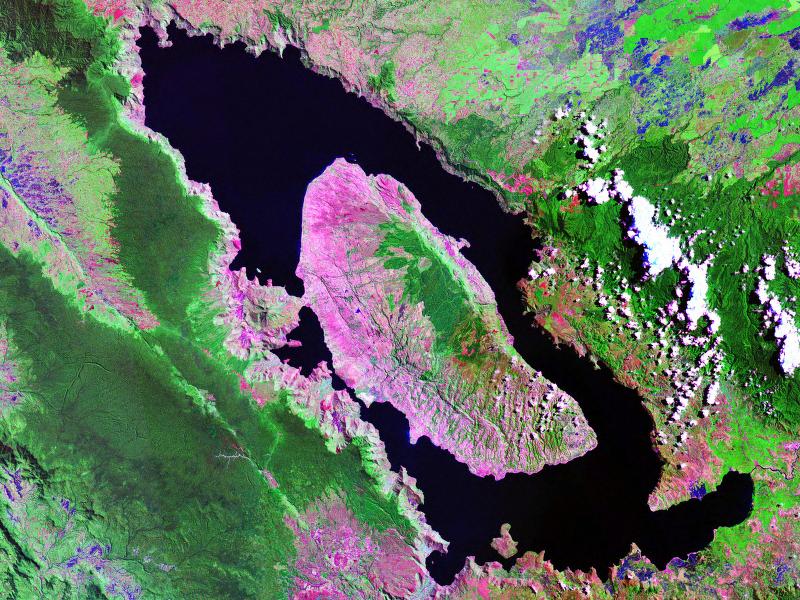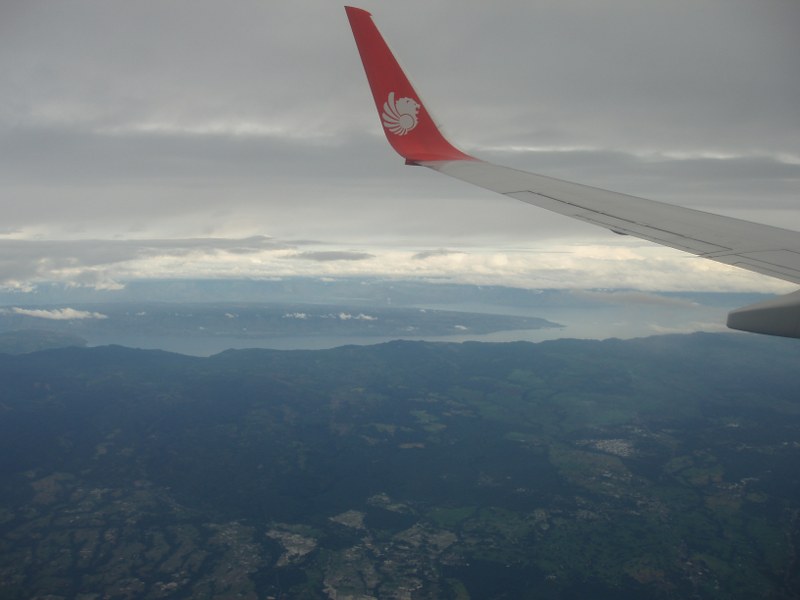
Lake Toba is a lake and supervolcano, 100 kilometres long and 30 kilometres wide, and 505 metres (1,666 ft) at its deepest point. Located in the middle of the northern part of the Indonesian island of Sumatra with a surface elevation of about 900 metres (2,953 ft), It is the largest volcanic lake in the world. In addition, it is the site of a supervolcanic eruption that occurred about 74,000 years ago, a massive climate-changing event. The eruption is believed to have had a VEI intensity of 8. This eruption is believed to have been the largest anywhere on Earth in the last 25 million years. According to the Toba catastrophe theory to which some anthropologists and archeologists subscribe, it had global consequences, killing most humans then alive and creating a population bottleneck in Central Eastern Africa and India that affected the genetic inheritance of all humans today.

The Toba caldera complex in Northern Sumatra, Indonesia consists of four overlapping volcanic craters that adjoin the Sumatran "volcanic front". The youngest and fourth caldera is the world's largest Quaternary caldera (100 by 30 kilometres) and intercepts the three older calderas. An estimate of 2500-3000 cubic kilometres of dense-rock equivalent pyroclastic material, known the Youngest Toba tuff, was blasted from the youngest caldera during one of the largest single eruptions in geologic history. Following the "Youngest Toba tuff eruption", a typical resurgent dome formed within the new caldera, joining two half-domes separated by a longitudinal graben.
There are at least four cones, four stratovolcanoes and three craters visible in the lake. The Tandukbenua cone on the NW edge of the caldera is relatively lacking in vegetation, suggesting a young age of only several hundred years. Also, the Pusubukit volcano on the south edge of the caldera is solfatarically active.

Lake Toba offers a nurturing environment for fish such as tilapia mossambica, aplocheilus panchax, lebistes reticulatus, osphronemus goramy, trichogaster trichopterus, channa striata, channa gachua, clarias batrachus, clarias nieuhofi, clarias. sp., nemachilus fasciatus, cyprinus carpio, puntius javanicus, puntius binotatus, osteochilus nasselti, lissochilus sp., labeobarbus sora, and rasbora sp
Many other types of plants and animals live within the boundaries of Lake Toba. Flora organisms include various types of phytoplankton, emerged macrophytes, floating macrophytes, and submerged macrophytes. Fauna include several variations of zooplankton and benthos.

The Toba caldera complex in Northern Sumatra, Indonesia consists of four overlapping volcanic craters that adjoin the Sumatran "volcanic front". The youngest and fourth caldera is the world's largest Quaternary caldera (100 by 30 kilometres) and intercepts the three older calderas. An estimate of 2500-3000 cubic kilometres of dense-rock equivalent pyroclastic material, known the Youngest Toba tuff, was blasted from the youngest caldera during one of the largest single eruptions in geologic history. Following the "Youngest Toba tuff eruption", a typical resurgent dome formed within the new caldera, joining two half-domes separated by a longitudinal graben.
There are at least four cones, four stratovolcanoes and three craters visible in the lake. The Tandukbenua cone on the NW edge of the caldera is relatively lacking in vegetation, suggesting a young age of only several hundred years. Also, the Pusubukit volcano on the south edge of the caldera is solfatarically active.
Lake Toba offers a nurturing environment for fish such as tilapia mossambica, aplocheilus panchax, lebistes reticulatus, osphronemus goramy, trichogaster trichopterus, channa striata, channa gachua, clarias batrachus, clarias nieuhofi, clarias. sp., nemachilus fasciatus, cyprinus carpio, puntius javanicus, puntius binotatus, osteochilus nasselti, lissochilus sp., labeobarbus sora, and rasbora sp
Many other types of plants and animals live within the boundaries of Lake Toba. Flora organisms include various types of phytoplankton, emerged macrophytes, floating macrophytes, and submerged macrophytes. Fauna include several variations of zooplankton and benthos.

No comments:
Post a Comment